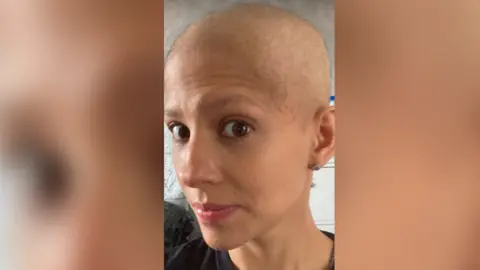
 Anastasia Cameron
Anastasia CameronFrom the age of seven Anastasia Cameron was turned away from hairdressers because she was told they “don’t do Afro hair”.
When she needed a wig after chemotherapy as an adult, little had changed, said the 39-year-old, who was diagnosed with breast cancer in 2021.
“It was awful, they basically said that I couldn’t have Afro hair,” she said. “You’re in a traumatic position after the diagnosis and dealing with the physical changes – but I was back to being isolated and had to manage the situation myself.”
The experience took her back to childhood when she was sent away from salons or mocked by her peers after cuts by inexperienced stylists.
 Anastasia Camerson
Anastasia Camerson“I just felt there was something wrong with me at that point,” she said.
“The stigma that I faced over a long period – it does traumatise you.”
A range of appropriately textured wigs were not available when Ms Cameron needed them after cancer treatment.
But changes to the NHS Wales contract now mean wig suppliers must offer a wider range for different ethnic communities.
This prompted Ms Cameron, a hairdresser and wig maker from Rhoose, Vale of Glamorgan, to bid for one of the NHS Wales contracts herself, meaning she now ensures cancer patients have the choice she did not.
She said there was still a huge skills gap among hairdressers who are not trained to cut her type of curl or Afro-textured hair.
“I recently went to have my first haircut after chemotherapy and had to talk the person through it because they didn’t know how to. I’ve got the experience to be able to do that, but I shouldn’t have to.”
 Anastasia Cameron
Anastasia CameronThat gap in appropriate aftercare is a familiar theme to Denise Mayhew, an ambassador for cancer charity Black Women Rising.
But disparities are also seen within healthcare itself. Her own treatment was outstanding, she said, but that is not the norm.
“We may all be one human race, but we’re definitely not treated the same,” said the 42-year-old who was diagnosed blood cancer multiple myeloma in 2018.
 Amanda Akokhia
Amanda Akokhia“You have people walking into their medical team saying ‘please treat me like a white woman so I can live’. That’s heartbreaking.”
She explained “myths and taboos” often caused barriers to diagnosis, including women being stereotyped as “black and strong”, meaning their pain is dismissed.
Cultural attitudes and religious beliefs within communities might make people hesitant about chemotherapy, though work is being done to “try and change the narrative”.

Breast cancer surgeon Zoe Barber acknowledged there was “a very rightful fear of being dismissed by a doctor”.
She said women from those groups were generally diagnosed at a later date as a result, leading to more invasive treatment and worse prognoses.
Ms Barber added support after treatment had not always been adequate.
A prosthetic offered after mastectomy “until very recently came in either a white colour or a pale peach colour and if you’re a woman who isn’t fair skinned, then that is so ‘othering’ for you”.
“We as clinicians should be advocating for those women as well. I think it’s still really important we recognise that we are still letting those women down and there’s far more work to be done.”
 Anastasia Cameron
Anastasia CameronJudi Rhys from Tenovus Cancer Care said a lack of data on patient ethnicity remained a “significant barrier to equitable healthcare”.
“We have called for the collection of patient ethnicity data since our research revealed it is not routinely gathered, despite a mandate to do so,” she said.
“We understand activity is on the horizon, but progress is far too slow.
“Not only could this data inform tailored treatment pathways, but it could also highlight underrepresented groups in research and clinical trials, disparities in screening uptake, and the need for essential services like hair replacement during treatment.”
The Welsh government said it took health inequality “very seriously” and a “number of improvements to data collection and analysis” had been implemented.
It added it would continue to work with NHS Wales to “determine how we can further capture data on ethnicity” so data is available when people are accessing healthcare.



Be the first to comment